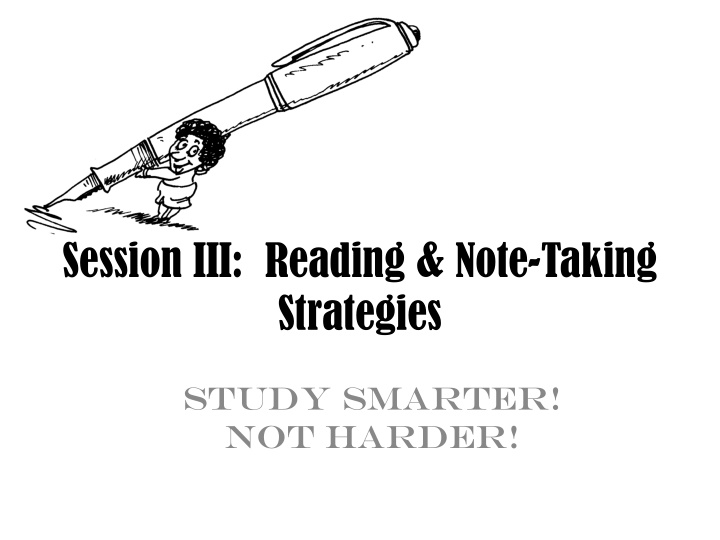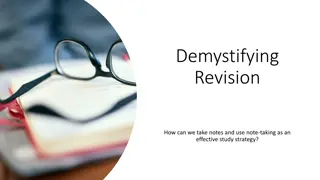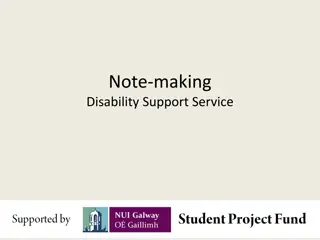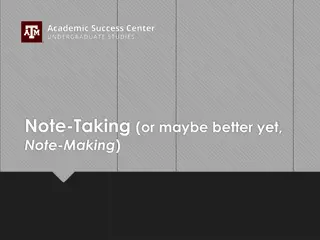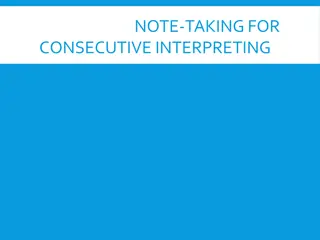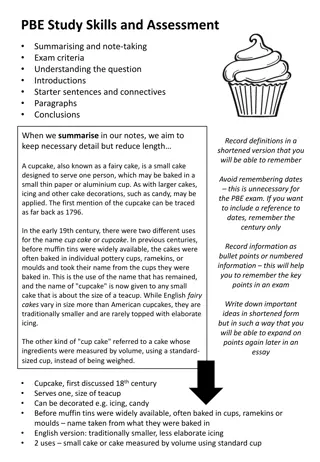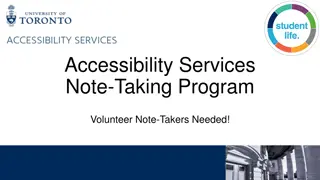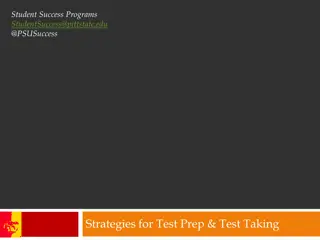Effective Note-Taking Strategies for Improved Learning
Improve your note-taking skills with strategies to enhance memory retention, organize information, and prepare for tests. Learn how active listening, different note formats like Cornell and REAP, and note-taking basics can help you study smarter, not harder.
Download Presentation

Please find below an Image/Link to download the presentation.
The content on the website is provided AS IS for your information and personal use only. It may not be sold, licensed, or shared on other websites without obtaining consent from the author.If you encounter any issues during the download, it is possible that the publisher has removed the file from their server.
You are allowed to download the files provided on this website for personal or commercial use, subject to the condition that they are used lawfully. All files are the property of their respective owners.
The content on the website is provided AS IS for your information and personal use only. It may not be sold, licensed, or shared on other websites without obtaining consent from the author.
E N D
Presentation Transcript
Session III: Reading & Note-Taking Strategies Study Smarter! Not Harder!
It All Starts With Listening If you re not listening you re NOT engaged, and your notes will reflect that. Listening vs. Hearing Actively listening Interest and understanding is YOUR responsibility Follow along When in doubt write it out
10 bad listening habits 1. Calling The Subject Dull 2. Criticizing The Speaker 3. Listening Only For Facts 4. Faking Attention 5. Tolerating Distraction Ask Questions!
Reasons to Take Notes Notes trigger memories of lecture/reading Your notes are often a source of valuable clues for what information is important (i.e., what will show up on the next test). Notes inscribe information kinesthetically Taking notes helps you to concentrate in class Notes create a resource for test preparation Your notes often contain information that cannot be found elsewhere (i.e., in your textbook).
Note-Taking Basics Use Abbreviations Be Brief Translate Organize Write Legibly Don t worry about spelling/grammar Leave Extra Space Look Back!
Different Types of Notes Cornell REAP Outline Format Webbing/Mapping
Cornell Different parts of the notebook paper have different functions. Notes are recorded on one half, key words and concepts are recorded in another area called the recall column, and a summary is recorded at the bottom of the paper. Record Reduce Recite Reflect Summary Advantages: Organized Quickly identify key words and concepts Easily used as a study guide Easy to locate information
Reap Strategy Purposes of the strategy: organize notes make course content more personal Class notes are taken on one side of the paper and the opposite page is used for recording memory triggers and related information.
REAP STRATEGY Divide Paper (Triggers, REAP, Class Notes) Takes notes only on the right-hand pages. Use short sentences and skip lines between major ideas. Record Triggers Trigger column = record words, phrases, or visual images that will trigger the main idea in the notes section. Fill in this section immediately or shortly after class. Record REAP Words The REAP column should also be filled in immediately or shortly after class. In the REAP column, the student writes words or phrases that... R Relate the material to his/her own life E Extend the material outward into the outside world A Actualize the material= how information might work in the world P Profit from the ideas - consider how society might profit from the ideas
OUTLINE FORMAT Information is arranged from general to specific The format may be used while recording notes, or it may be employed when recopying and reorganizing notes. Helps to detect and understand relationships and associations among different pieces of information.
Outline format Develop a Template Use the main ideas in the lecture/text as headings. The details are filled in during lecture/reading. Arrangement of Information Each major section of the outline should cover one major topic. Fill in the levels with details Symbols Common symbols: Roman numerals, upper and lower case letters, numbers, circles and squares Short phrases, symbols, shorthand, and abbreviations may be used to record notes in the outline. Drawings or figures may be incorporated
Webbing & mapping less conventional methods of organizing information. Notes may be recopied and reorganized into concept maps, spider maps, flow charts, and other formats.
Try it out! Take out your notes from a class this week. Compare them with the examples given today. Examine where your notes: Are missing info Need clarification Are able/unable to answer the Learning Target Need reorganization
